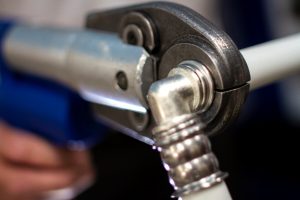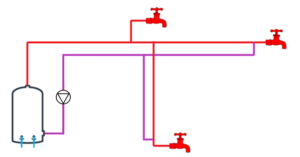How MLCP Press-Fit Compares To Plastic Push-Fit
When it comes to plumbing solutions, there are many options available on the market. Two popular choices are press-fit and push-fit piping. In our blog, learn how MLCP press-fit compares to plastic push-fit plumbing.
What is MLCP?
Multilayer Composite Pipes (MLCP) is a type of piping that is made up of multiple layers of different materials. The inner layer is typically made of cross-linked polyethylene (PEX), which is a flexible and durable material. The outer layer is made of aluminum, which provides strength and stability to the pipe. The layers are bonded together using a special adhesive, creating a strong and reliable pipe.
Over the last few years, we’ve helped numerous installers to move to MLCP, resulting in faster, cleaner, more secure, and more profitable installations. Find out more about Multipipe’s MLCP here.
What is Push-Fit Piping?
Push-fit piping, also known as push-to-connect or push-fit fittings, is a type of piping that uses a push-fit connection system. This means that the pipes are connected by simply pushing them together, without the need for any tools or adhesives. Push-fit piping is typically made of plastic, such as polyethylene (PE) or polypropylene (PP).

In March 2023, leading insurance company Zurich, shared they were seeing an increasing number of leaks relating solvent-related pipe leaks. One claim involved almost £800,000 worth of damage!
Paul Redington, a Regional Major Loss Manager at Zurich has said: “Plastic pipework is here to stay but Zurich and our forensic experts Hawkins are seeing an increasing number of escape of water losses involving its use. We are concerned that plastic push-fit systems for example require less skill and training to install, and if not fitted-properly can leak, causing significant loss and disruption.”
Now that we’ve covered the basics of MLCP and push-fit piping, let’s take a closer look at how they compare in terms of various factors.
Here’s how MLCP press-fit compares to plastic push-fit plumbing:
Secondary Circulation Systems
Any pipe manufacturer under BS7291 that covers all plastic push-fit ranges is not suitable for a secondary recirculation system and, if fitted, can cause leaks, and at worse can lead to full bore detachments causing serious leaks and damage. The pipe manufacturers for these pipes will not cover your system if it is used on this type of water.
However, because of how our pipework is made, MLCP can be used with recirculation systems as Multipipe MLCP is made to a different standard than plastic pipe. Find out more about secondary recirculation systems here.
Installation
Plastic push-fit, as you will know, is very widely available. The ease of application is often seen as an advantage; no specialist tooling other than a cheap pipe cutter is needed to make a joint. However, we see this as deskilling of the plumbing industry and potentially harmful, as this can lead to issues in water hygiene like Legionnaires’ disease.
In fact, there are no laws stopping any general public from purchasing the material to do their own plumbing. Which when you consider insurance companies are reporting the highest level of water escape, this could become a harmful and costly problem.
MLC helps by ensuring specialist tooling is required, and Multipipe would only sell our products to the plumbing and heating trade, trying where we can to regulate this unregulated industry. This is why we can offer a 25-year insurance back warranty with our products.
Full Bore Detachment
Because plastic push-fit relies on fitment on the outside using a grab ring that “bites into the pipe”, if anything happens to the outer layer, the fitting can slip and has been known to lead to a full detachment of the fitting. This can lead to over 10 litres per minute of water entering the property, which very quickly can lead to irreversible damage.
Multipipe’s press-fit system has been manufactured to the highest quality with multiple safety points, including leak path before the press, and inspection windows. This ensures when pressed, you will have decades of leak-free issues.
More Secure Fittings
Compared to traditional push-fit piping, MLCP secure fittings can’t be knocked or blown off. This extra security not only benefits your customer, who will get to enjoy their new plumbing with greater assurance about its quality and longevity, but can also benefit you as the installer. You will spend less time having to explain why fittings and joints have come loose and repairing these joints, meaning your workmanship won’t be questioned by customers and your brand will be seen as a more professional and quality driven.
Durability
Once bent, MLCP completely keeps its shape, lessening the need for fastening points in comparison to push-fit piping. Again, this leads to a reduction in installation time. But what you are really saving is money. With less need for fastening points, you won’t have to buy as many fittings to complete the installation, increasing the efficiency of both yours, and your client’s budget.
Low Heat Expansion
Some push-fit systems expand 8 times more than MLC at normal system temperatures, meaning the pipework can move after installation causing noise and stress on the fitting.
Thanks to the specialist technology used to create the temperature resistant PE-RT, MLCP has a low heat expansion, performing comparatively to that of metal piping with the advantages of versatile plastic pipe. The low heat expansion makes MLCP incredibly durable – so much so that we give it a 25-year guarantee, with 50 years upon application.
Sealed For Hygiene
Most push-fit systems seal with an O-ring on the outside of the pipe, which under normal site conditions can get damaged or dirty.
Multipipe’s MLCP is sealed from inside the pipe, making it far more resistant to damage and reducing the potential for leaks in the system. WRAS approved, MLCP is ideal for transporting drinking water hygienically, making it a popular choice for health industry applications such as hospitals.
Conclusion
In conclusion, while traditional products are good enough for the job, you want to stand out amongst your competition. Using the best, most innovative products will ensure that you are able to complete jobs quickly and efficiently.
At Multipipe, we care passionately about raising UK plumbers’ operational standards and our societies’ perception of the trade. That’s why we supply quality products like MLCP.
To find out more about MLCP, click HERE. If you’re interested in purchasing MLCP or training on our systems, email our sales team on [email protected] or call our friendly team on 01245 227630.




